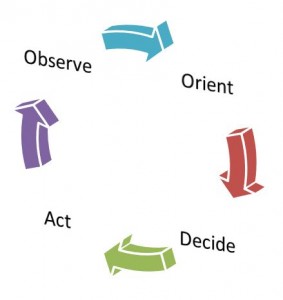The resurgence or maybe recognition of the use of the The OODA Loop as a basis for much of the current ideas surrounding Iterations, Rapid Development Cycles and Decision Making. What makes the OODA Loop such a popular subject? When we first think of the OODA Loop we think of fast competitive cycles needed by a fighter pilot to gain a differential advantage. Is that the reason?
 A little more insight was provided several years ago in an article, The Strategy of the Fighter Pilot written by: Keith H. Hammonds for Fast Company. An excerpt from the article:
A little more insight was provided several years ago in an article, The Strategy of the Fighter Pilot written by: Keith H. Hammonds for Fast Company. An excerpt from the article:
Business is a dogfight. Your job as a leader: Outmaneuver the competition, respond decisively to fast-changing conditions, and defeat your rivals. That’s why the OODA loop, the brainchild of “40 Second” Boyd, an unconventional fighter pilot, is one of today’s most important ideas in battle or in business.
Bower and Hout’s classic example — and one that Boyd also studied — was Toyota, which designed its organization to speed information, decisions, and materials through four interrelated cycles: product development, ordering, plant scheduling, and production. Self-organized, multifunctional teams at Toyota, they observed, developed products and manufacturing processes in response to demand, turning out new models in just three years compared with Detroit’s cycle of four or five.
Systems like Toyota’s worked so well, Boyd argued, because of schwerpunkt, a German term meaning organizational focus. Schwerpunkt, Boyd wrote, “represents a unifying medium that provides a directed way to tie initiative of many subordinate actions with superior intent as a basis to diminish friction and compress time.” That is, employees decide and act locally, but they are guided by a keen understanding of the bigger picture.
In effective organizations, schwerpunkt connects vibrant OODA loops that are operating concurrently at several levels. Workers close to the action stick to tactical loops, and their supervisors travel in operational loops, while leaders navigate much broader strategic and political loops. The loops inform each other: If everything is clicking, feedback from the tactical loops will guide decisions at higher loops and vice versa.
It has been noted in the latest work by such authors as Bll Dettmer, The Logical Thinking Process: A Systems Approach to Complex Problem Solving and Don Reinertsen, The Principles of Product Development Flow: Second Generation Lean Product Development
. Even more popular use of Boyd’s OODA Loop is the Lean Startup by Eric Reis and his influential writings on the Customer Development Cycle utilizing the OODA Loop as a basis.
Dr. Terry Barnhart, the Senior Director Strategy and Continuous Improvement at Pfizer Global R&D discussed the OODA Loop in a Business901 Podcast, Applying the OODA Loop to Lean. We expand this theory into some practical applications. One of the takeaways from the conversation is using the OODA Loop outside of rapid deployment. The use of it he expresses is in the adaption of it through the uses of various time cycles.
In the most common use of the OODA Loop, adaption is rather direct. At the strategic level it involves around adjusting procedures, systems, processes and ideology. Boyd advocated an agile cellular organization with some explicit control mechanism and feedback loops but one more reliant on common frames of reference and shared ideas. He always contended that Command was about clarity of ones goals and philosophies versus the traditional form of command and control thought of it in a hierarchy structure. I enjoy the description that Frans Osinga discusses in his book Science, Strategy and War: The Strategic Theory of John Boyd (Strategy and History), (highly recommend – not an easy read though) is that “Higher Command must shape the Decision Space of subordinate commanders.“ Actually, that is a pretty good description of Standard Work, is it not?
Related Posts:
Key Marketing Concepts from the Korean War
Boyd’s Law of Iteration: Speed beats Quality :
One of my favorite Leadership videos.
